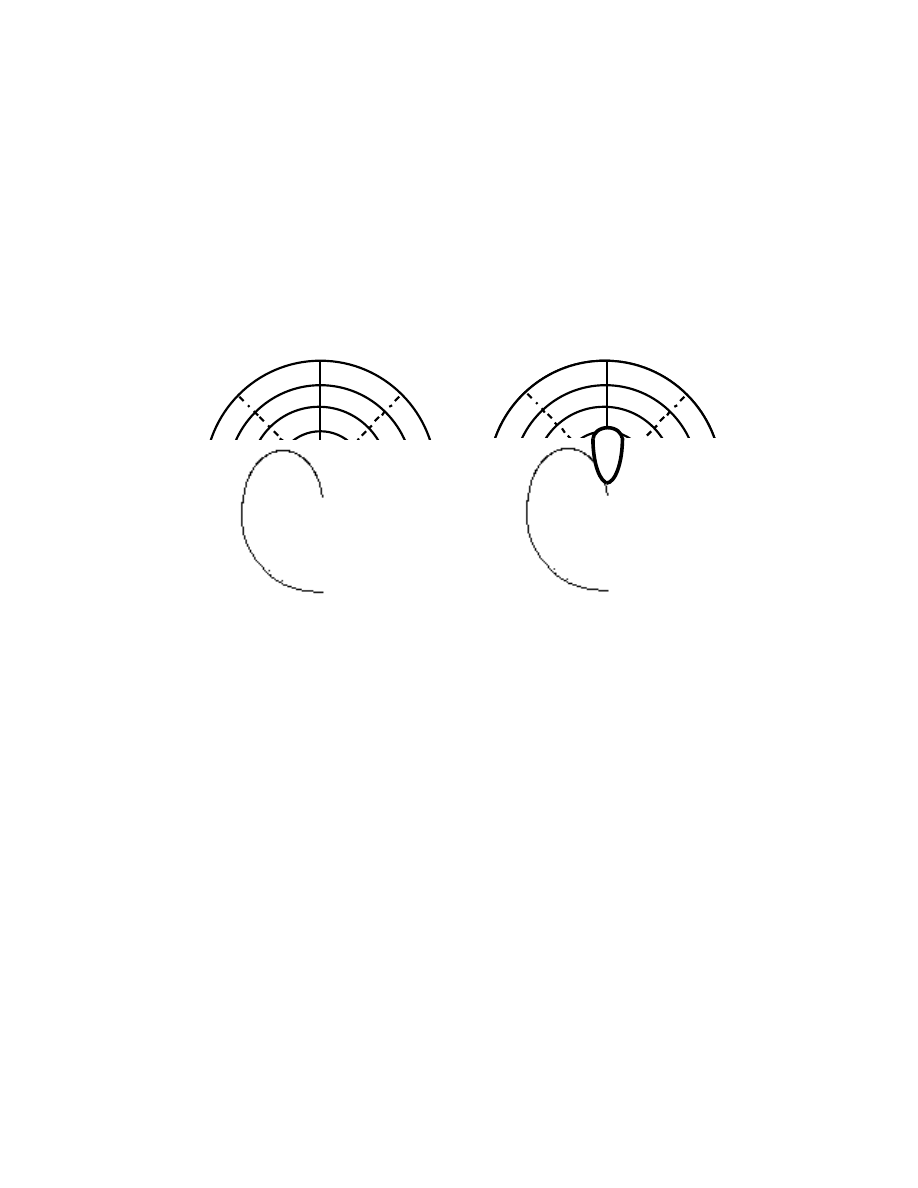ВУЗ: Казахская Национальная Академия Искусств им. Т. Жургенова
Категория: Учебное пособие
Дисциплина: Не указана
Добавлен: 03.02.2019
Просмотров: 12349
Скачиваний: 6

P
polar pattern: A circular, two-dimensional plot that indicates the directional response of a
transducer, such as a directional microphone. Whole polar patterns are commonly used to show
microphone response patterns, they also can indicate the dispersion of a speaker. In the dia-
gram below, points X and Y indicate response nulls in the hypercardioid microphone, which
represent optimal angles for the placement of stage monitors. A good microphone should
have a similar polar pattern from 200Hz to 10kHz, otherwise the mic will produce noticeable
off-axis coloration. Also called a polar diagram or response pattern. The cardioid pattern micro-
phone is most sensitive to sounds coming directly from the front and least sensitive to sounds
coming directly from the rear. The hypercardioid is most sensitive to sounds coming directly
from the front and least sensitive to sounds coming in the direction of X and Y, a good place
for stage monitors.
Polar Patterns
Cardioid
Front
Back
X
Y
Hypercardioid
Front
Back
pole: A portion of a filter circuit. The more poles a filter has, the more abrupt its rolloff slope
will be. Each pole causes a slope of 6dB per octave; typical filter configurations are two-pole
and four-pole (12dB/octave and 24dB/octave, respectively). See order.
Poly Mode: A MIDI reception mode in which a module responds to note messages on only
one channel, and plays as many of these notes at a time (polyphonically) as it can. In a guitar-to-
MIDI converter, Poly Mode allows multiple strings to share the same channel. Compare with
Mono Mode.
polyphonic: (1) Music which simultaneously has more than one independent melodic line.
(2) Capable of producing more than one note at a time. On most electronic organs, all of the
notes can be sounded polyphonically at once, but all synthesizers place a limit on how many
voices of polyphony are available. General MIDI-compliant synthesizers are required to pro-
vide 24 voices of polyphony. Compare with multitimbral.
poly pressure: Polyphonic pressure. A type of MIDI Channel Voice message in which each
key senses and transmits aftertouch data independently. With poly pressure, if a chord is
played pressing into the top note, only this note will be modulated without affecting the oth-
ers. Expensive to implement, so rarely seen. Also called poly aftertouch or key pressure. Com-
pare with channel pressure.

P
pop a track: The act of aligning a two-pop exactly nine feet from the start mark, either on mag
film or on a bench, or in a digital audio workstation.
popcorn noise: Film expression for ambient noise in a theater environment that influence the
low end of the dynamic range, and how soft a sound will be heard (or “read”) in an actual
theater. See Little Old Ladies with Umbrellas.
pop filter: A device that is used to reduce the popping, distortion caused by overmodulation of a
microphone, usually as a result of placing it too close to the sound source. It commonly occurs
with the vocal plosives: b, p, and t. Also called a pop screen, windscreen, or windshield.
popping: See pop filter.
port: (1) An opening in the front surface or baffle of a loudspeaker enclosure, called a ported
enclosure. (2) One or more openings on the body of a unidirectional microphone, either rear-
entry or side-entry. Passing through the port(s), sound waves reach the rear side of the dia-
phragm and, through phase cancellation or reinforcement, contribute to its directional response
pattern. See acoustic labyrinth.
portamento: (1) A continuous movement in pitch from one note to another without step. In-
struments with notes of fixed pitch, such as the piano, are unable to do this, but the human
voice, fretless instruments, e.g., violins, and instruments fitted with slides, e.g., trombones,
can. It is a different effect from glissando. (2) See glide. (3) One of the defined MIDI Controller
Change messages used to switch a synthesizer’s portamento on or off.
Portamento Time: One of the defined MIDI Controller Change messages assigned to the pa-
rameter in a synthesizer which determines the time taken for portamento to occur.
positional reference: A signal that provides location information that various devices can use
to establish synchronization during playback and recording.
post: (1) Means “after,” as opposed to pre. In recording studio parlance, it is used to indicate
that the signal has already had the designated effect added, such as post-equalization, post-
effects, or post-fader. Also used as an abbreviation for post-production. (2) Binding post. A
connector, consisting of a threaded shaft and nut, used to terminate bare wire. Usually found
on loudspeakers and occasionally amplifiers. See pigtail.
post de-emphasis: The same as de-emphasis.
post fade listen: Also called after-fade listen AFL. Signal routing within a mixing console to al-
low audio signals to be monitored at the level set by the fader on that input, rather than
monitoring the level coming to the input, as in pre-fade listen.. Aux sends are usually monitored
post-fader. Because of the ambiguity of the abbreviation PFL, be sure to use AFL (after-fade
listen) for post-fade listen as PFL is generally taken to denote pre-fade listen.
post-fader send: See effects send.

P
post-production: (1) In audio, a term used for tasks which have to be done after mixing is
complete and the master tape has been made. These include further editing, grouping of indi-
vidual tracks into an album, and for CD, the addition of subcode. (2) Any work on a recording,
film, or video that is done after the main recording session or filming is completed. Typical
post-production work can include editing, mixdown, looping, sound cutting, making of titles,
etc.
post-roll: (1) The number of beats/amount of time a sample ends after the playback-end
marker. (2) In SMPTE timecode synchronization for videotape post-production, the number of
seconds and/or frames specified which are automatically added to any timecode address sub-
sequently specified as a record-out point. Thus, when inserting dialog or music, on each take
master and slave machines will continue to roll for the post-roll duration after recording is
stopped. This prevents the type of wow that occurs when a transport is stopped while the
electronics are still recording. Some brands of synchronizer add the post-roll to the mark-out
rather than the record-out location.
post-score: To compose and/or produce a musical score or jingle after the film or videotape
for the production has been shot, and usually after a fine cut is completed. The composer can
then spot cues, take counts, locate hits and really tailor the music to the visuals.
post-stripe: To re-lay the mixed soundtrack onto the edited video master, or onto a copy made
from it.
post-sync: Post-synchronization. (1) ADR recording with M&E made to synchronize with an
existing film or video tape, usually for translation of a foreign-language film. This term is used
mainly in Europe, while in the U.S., the term ADR is used as a synonym. (2) The recording of
sound to be added to the sync sound.
pot: Potentiometer. A device (commonly attached to a knob or slider) used to adjust some as-
pect of the signal being passed through it, or to send out a control signal corresponding to its
position. A variable resistor, usually controlled by a rotary knob, is used extensively as a vol-
ume control, tone control, etc. The term is also sometimes used for a step-type attenuator.
power: (1) Electric power: The time-rate of doing work or the rate at which energy is used. A
watt of electrical power is the use of one joule of energy per second. Watts of electrical energy
equals volts times amperes. See Appendix B. (2) Acoustic power: The number of watts of en-
ergy produced by any sound source or transducer. See acoustic intensity.
power amplifier: A device that accepts a low-level audio signal and strengthens, or amplifies,
it to a suitable voltage and current level adequate to drive a loudspeaker or similar load. See
preamplifier, active, differential amplifier, integrated amplifier, combining amplifier.
power bandwidth: The bandwidth of an audio device such as a power amplifier, measured
while delivering its full rated load. This is limited by the slew rate of the device and is always
narrower than the small signal bandwidth.
power factor: See also watt, VA.
power level: See level.
power ratio: See decibel, voltage gain.

P
PPM: Peak Program Meter. Similar to a VU meter in appearance, but which responds to the
peak level of the signal, rather than the average level. PPMs read the peak-to-peak value, i.e.,
the voltage swing between the negative and positive peaks. However, they still don’t read ab-
solute peak values, because clipped peaks shorter than a ms or so are generally inaudible.
Peak detection usually is most effective with percussive sounds. See also modulometer.
ppq: Pulses Per Quarter-note. The usual measure of a sequencer’s clock resolution. Sometimes
written as ppqn.
PQ subcode: These control bytes contain the timing information which allows the CD player
to cue instantly to the beginning of each selection, display the selection’s number and running
time, and provide a continuous display of elapsed time. See Control and Display signals.
preamplifier: (1) In an audio system, the first amplifier to accept the signal from the transducer
is generally called a preamplifier. Preamps must usually accept very low-level, e.g., mic-level,
signals and amplify them to line-level without adding appreciable noise. (2) A small amplifier
built into a condenser microphone to boost the very low output level of the capsule before trans-
mission over the mic cable.
Precedence Effect: See Haas Effect.
pre-delay: In reverberation, the time between the incident sound and the first sound reflection is
heard.
pre-echo: (1) Depending upon the width of each frequency band in a transform coding scheme,
it is possible for the decoder to produce variable amounts of pre-echo. For example, a transient
that has its rising edge contained within a frequency band: the codec quite correctly detects the
transient’s presence and codes the information within the appropriate band, and also uses that
information to re-use bits from surrounding masked envelopes. Upon decoding, the output
level is turned on the for complete duration of the coded frequency band, which means that
the signal will be heard before the arrival of the actual transient. Such pre-echoes sound very
much like analog tape print-through and may produce unacceptable results, particularly on
material containing large numbers of sharp level excursions. (2) In room acoustics, any early
reflections of sound that occur within about 40 ms, the shortest time for which the ear can dis-
tinguish two non-simultaneous sounds. Some digital reverb devices include simulated pre-
echoes as a part of their hall simulation program.
pre-emphasis: (1) Generally, the process of equalizing a signal to increase the content of a de-
sired frequency band before the signal is sent to another device. (2) A type of high-frequency
boost applied to signals about to be broadcast on FM stations or recorded on tape to reduce the
apparent noise level. Pre-emphasis brings the high-frequency content of the music up to a
level further above the noise level of the recording medium. In order to restore the proper bal-
ance of high and low frequencies to the reproduced music signal, the boost added by pre-
emphasis must be removed by a complementary cut, called de-emphasis. See equalization curve.
pre-fade: A fade-out starting at a predetermined time so that it finishes precisely at the end of a
recording.

P
pre-fade listen: Abbreviated PFL. A monitoring point placed before a fader on a mixing desk
so that the signal can be listened to before being boost or cut for recording or broadcasting, i.e.,
the incoming signal can be heard regardless of the position of the fader on that particular in-
put. Note that aux sends are generally monitored post-fade listen.
pre-fader send: See monitor send.
pregap: A mixed-mode CD encoding format designed to hide the computer data at the front of
the audio portion of the CD, between index 0 and index 1 of track one. A CD player still
thinks it’s an audio-format CD, while a computer thinks it’s a CD-ROM. Pregap improves
upon mixed-mode by not allowing the audio user to access the Enhanced CD track directly, but
there are other problems: patent disputes and a bug in Windows’95 makes the pregap track
inaccessible to PC users. See CD Extra.
pre-lay: Usually stands for the act of editing sound onto a multitrack, i.e., multitrack editing.
premix: (1) (noun) If many tracks of effects or music are required for a specific scene, the mix-
ing engineer may elect to mix all of these effects together onto a single strip of magnetic film or
onto a single track (or at least fewer tracks) of the multitrack master, then use this one track
during the final mix rather than the individual effects tracks. Because this effects mix is done
before the final mix, it is called the pre-mix. Dialog premixing often does not actually reduce
the number of tracks that will go into the final mix, but instead just copies a cut track across
with careful equalization and fader moves. See binky. (2) (verb) To mix and bounce two or
more tracks of a multitrack tape before making the final mix of all tracks. Done to free up
tracks for additional instruments or voices, or to save time in the final mix by having sections
already mixed.
pre-production: A term used for those tasks which can, or need to, be done before the actual
recording or filming is made. A pre-production suite may be provided for the programming
of synths and preparation of samples and sequences for use during the session.
pre-roll: (1) The number of beats/amount of time a sample starts before the playback marker.
(2) In SMPTE timecode synchronization for videotape post-production, a number of seconds
and/or frames which are to be automatically subtracted from any record-in point (some brands
of synchronizer subtract the pre-roll from the mark-in point, rather than the record-in point.)
The synchronizer will then return master and slave machines to a point located ahead of the
record-in by the duration of the specified pre-roll. This assures that all machines will be up to
speed, properly interlocked, and that the talent can find their place and be ready to perform by
the actual record-in point. For example, if the record-in point is 20:10:00, and the pre-roll is
5:00, the deck will actually stop at 20:05:00, precisely five seconds before the specified record-
in. See post-roll.
pre-score: To compose and/or produce a musical score or jingle before the film or video has
been shot. This can be done in anticipation of filming live actors to playback, or in animation
to provide the animator with exact scene lengths, cue points, and other information necessary
to match the animated scene to the music. Almost all animated films are pre-scored, including
dialog and effects, after which frame counts are taken from this in the music so that the ani-
mators can time actions to fit the soundtrack. The opposite of post-score.